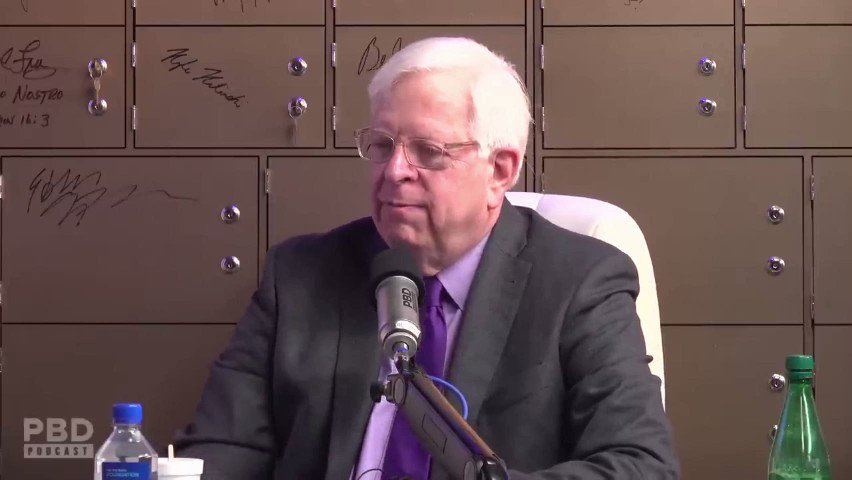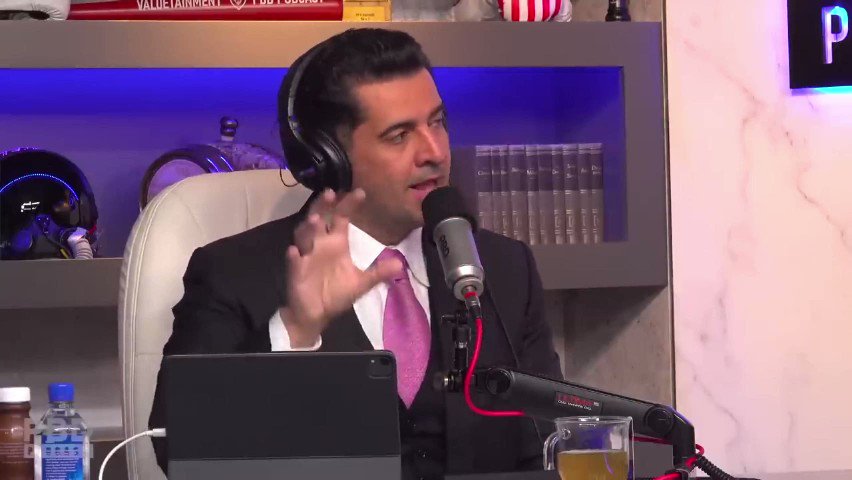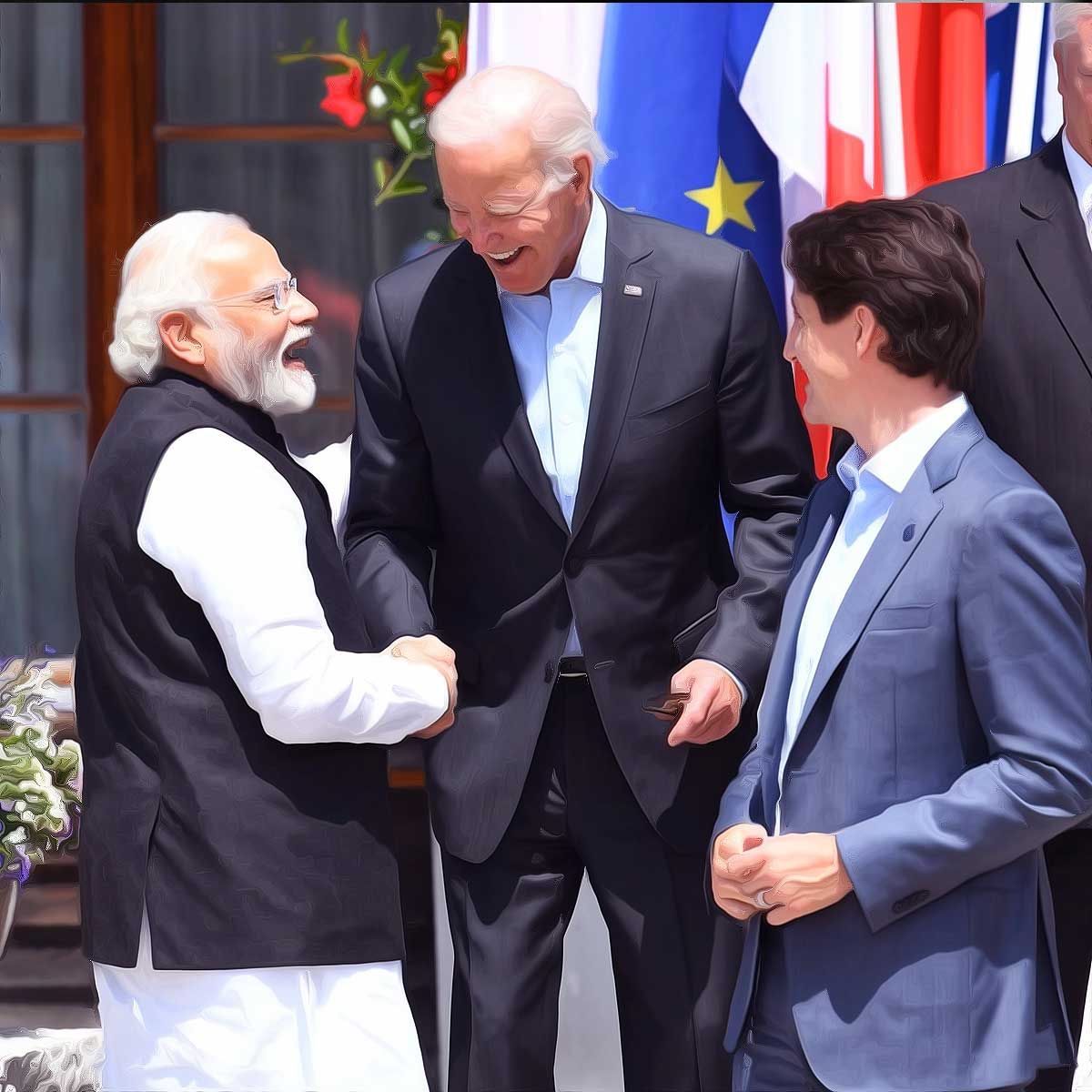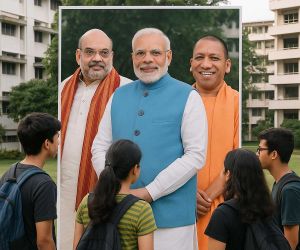MORE COVERAGE
Twitter Coverage
Satyaagrah
Written on
Satyaagrah
Written on
Satyaagrah
Written on
Satyaagrah
Written on
Satyaagrah
Written on
JOIN SATYAAGRAH SOCIAL MEDIA
"Connectivity is power; India realizes it first": India takes the lead in the Himalayan railway race, outpacing China in connecting with Nepal, amid geopolitical intricacies, as the tracks extends, Nepal emerges as a crucial nexus in this Asian power play
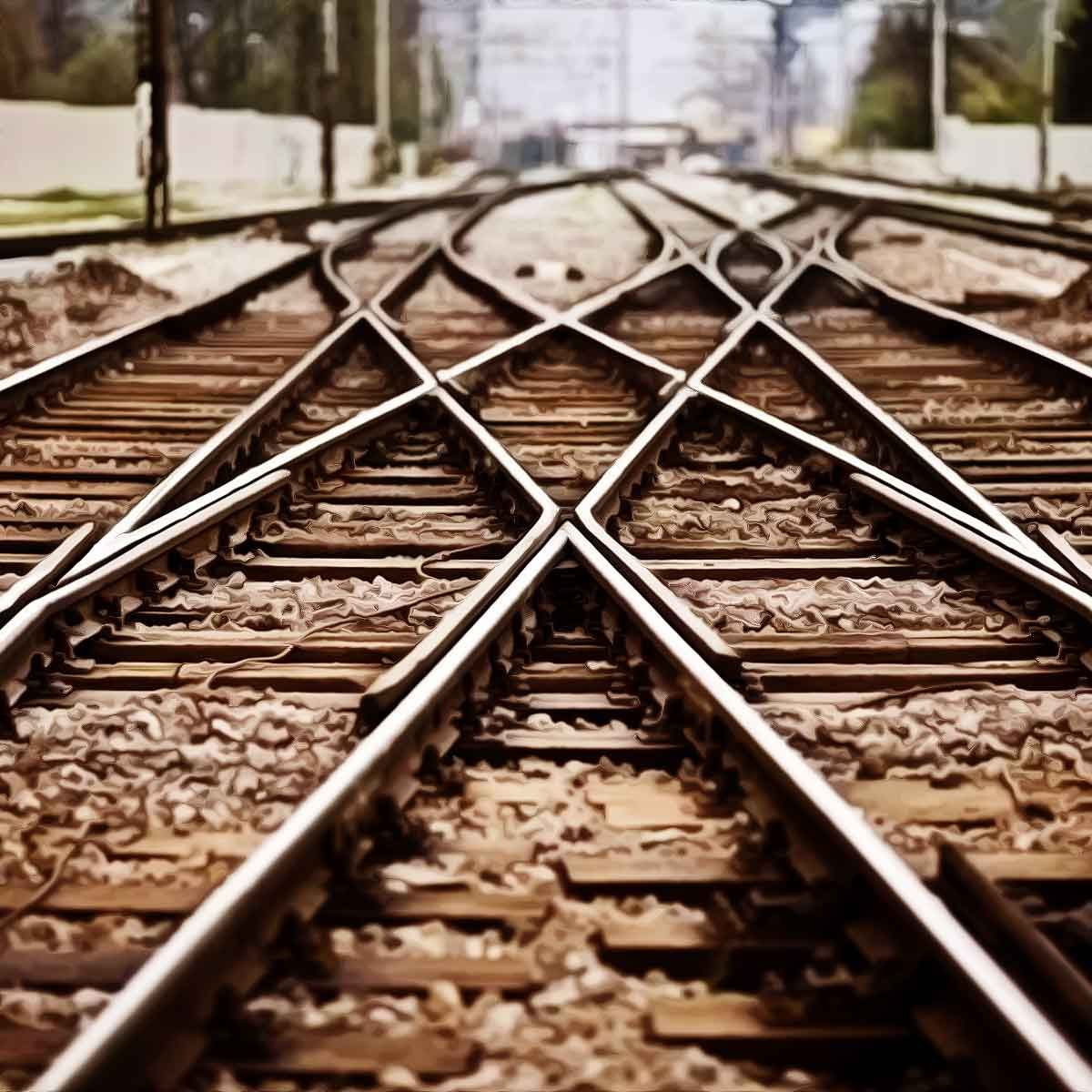
In the vibrant capital of Nepal, Kathmandu, there’s an electrifying buzz around the railway networks. The reason? India, with its rich history and unparalleled growth, has recently showcased its prominent stature by handing over the Final Location Survey of the upcoming cross-border railway project that's intended to link Raxaul to Kathmandu. This gesture, symbolizing India's commitment and initiative, contrasts with China's own accelerating efforts to create a railway bond with the heart of Nepal, Kathmandu.
|
Picture two mammoth nations, each influential in their unique ways, vying to weave an intricate web of railway tracks across the undulating landscapes of Nepal. The objective? Deepening ties with the Himalayan jewel and expanding their geopolitical influence. Analysts, both keen-eyed and experienced, perceive this tug-of-war over railway projects as a subtle dance of diplomacy, where the grand railway tracks act as strings of alliance.
India, displaying its traditional flair for innovation and rapid action, has arguably moved a chess piece ahead in this elaborate game of geopolitics. The southern nation hasn't just proposed an idea; it has taken proactive steps. They’ve meticulously prepared what’s known as the Final Location Survey, which in layman's terms, is a comprehensive blueprint or Detailed Project Report. This precious document, a symbol of mutual trust and collaboration, has been graciously shared with the Nepalese authorities for insights and feedback.
Mr. Rohit Bisural, the esteemed director-general of Nepal's Department of Railway, candidly shared with the media, “We're deeply engrossed in understanding the insights of the Final Location Survey." This enthusiasm from the Nepalese side is heartening and showcases the deep-rooted camaraderie between the two nations.
Meanwhile, our friends from the East, China, are also making inroads. Their focus? The Kerung-Kathmandu Railway. According to the whispers from the corridors of Nepal's railway departments, the diligent Chinese technical team has been on the ground since March. Their mission is to conduct a holistic field survey, a fundamental step in understanding the lay of the land. Mr. Bisural, ensuring transparency, mentioned, “The Chinese have almost concluded their field survey."
Digging deeper into China's meticulous approach, their team is set to undertake a series of technical tasks. These range from an aerial view survey, capturing the breathtaking Nepalese landscapes from the skies, to intensive geological mapping. The goal is to prepare a report which encompasses the viability, engineering requirements, and constructive challenges of the proposed railway.
|
Last December, there was another notable chapter in this ongoing narrative. A specialized team from the China Railway First Survey and Design Institute Group graced Nepal with their expertise. They were here for what’s known as a reconnaissance survey, essentially a pioneer study in regions yet untouched by such infrastructural developments.
Detailing further plans, Bisural revealed that the exhaustive feasibility study by the Chinese is charted for a 42-month timeline. A remarkable fact here is China's commitment to funding this endeavor. They are generously extending a grant assistance amounting to RMB 180 million (NPR3.33 billion) to Nepal, underscoring their interest and investment in this project.
Taking a quick trip down memory lane, China's ambition to lay down railway tracks in Nepal was conceived during Prime Minister KP Sharma Oli's memorable visit to China back in March 2016. That visit was pivotal. Both nations resonated with the idea of crafting a cross-border railway, leading to mutual agreements and brainstorming sessions. The enthusiasm was palpable, with technical teams from China arriving in Nepal for preliminary studies in late 2017 and mid-2018.
Sealing their intent, both nations inked a MoU in June 2018 during Oli’s subsequent visit to China. This commitment was reaffirmed in 2019 when Chinese President Xi Jinping toured Kathmandu. However, the unexpected advent of the COVID-19 pandemic momentarily paused these plans. Yet, as the world emerged from the clutches of the pandemic, China, displaying resilience, dispatched its team for the feasibility study in the final weeks of last year.
To sum up, this tale of railways isn't merely about tracks and trains. It’s about aspirations, geopolitical strategies, and the undying spirit of collaboration. While the road ahead is long and winding, the exciting journey has undeniably begun.
|
India's Strategic Play: Rising Above in Nepal’s Railway Landscape
While the ever-evolving political dynamics and infrastructural ambitions create an intriguing canvas in the Nepal railway scenario, India’s capital, New Delhi, remains undeterred and resolute. Riding high on its consistent vision for the Raxaul-Kathmandu railway linkage, India’s intentions are clear and strategic.
Lok Raj Baral, the former Nepali ambassador to India, threw light on the situation, elucidating that India's alertness stems from its apprehensions about China, a country perceived as a far greater threat than Pakistan. Baral remarked, “India has surpassed Pakistan economically and emerged as a global force to reckon with. Naturally, the rising influence of an adversary like China in Nepal, which India cherishes as a close ally, is cause for concern.”
Historically, the grandeur of the Himalayas has acted as a robust security blanket for India. Therefore, any significant connectivity between Nepal and China might dilute this perceived security. "Given the current strained ties between India and China, especially post the tumultuous Galwan Valley clash in May 2020, India observes Nepal's plans of railway connectivity with China with a degree of apprehension," Baral added, giving insights into the geopolitical intricacies.
In recent times, Nepal's visionaries aspired to position the Himalayan nation as a bridge between the two Asian giants, India and China. But given the ongoing chilly Indo-China relationship, realizing this dream feels like a distant echo. Baral lamented, "Without trust between India and China, Nepal’s aspiration of being a 'dynamic bridge' appears elusive."
Surya Raj Acharya, a luminary in infrastructure policy, planning, and management, emphasized that if Nepal wishes to bolster its railway ties with China, it must earnestly address India's security concerns.
However, the narrative isn't just about politics and security. A crucial aspect that many experts are dissecting is the different railway gauge systems adopted by India and China. A historical perspective is worth noting: during the era of the Great Game, to prevent potential invasions, the Russian empire adopted a unique railway gauge, making it broader by 89mm than the standard European size of 1435 mm.
India envisions extending its broad-gauge railway into Nepal, while China’s sights are set on its standard gauge. These gauge distinctions, not merely technical in nature, can significantly influence the flow of transport and goods.
Within Nepal, a debate is brewing: should they adopt the broad gauge akin to India or the standard one? While many of Nepal's railways, like the East-Way Railway, are under the standard gauge system, some, like the Jayanagar-Kurtha Railway, have been upgraded to broad gauge with India’s support.
|
Ananta Acharya, the former director-general of Nepal’s Department of Railway, advocated for the broad gauge. He reasoned, “Given Nepal’s robust trade ties and the substantial people-to-people movement with India, a common gauge system would drastically cut trade costs.”
Acharya further illustrated the potential benefits, explaining how Nepal could act as a conduit, linking India's northeastern region with the capital, New Delhi. Additionally, sourcing spare parts for railways would be more straightforward from India, ensuring minimal disruption during maintenance.
Nevertheless, the road ahead for Nepal's cross-border railway dreams is long and challenging. Rohit Bisural, while emphasizing the expensive nature of the projects, stated, "It's pivotal for the government to meticulously analyze the feasibility studies before green-lighting these projects."
Citing costs, a senior official from the railway department revealed that the Raxaul-Kathmandu railway is projected at INR 260 billion (NPR 416 billion) covering a length of 141 km, with nearly 41 km tunneling. The Kerung-Kathmandu Railway, while being cost-intensive, is also geographically challenging. A staggering 95% of this 73 km track will be underground!
As for China, besides their commitment within Nepal, they have to construct a railway to Nepal's border, linking to their existing network in Tibet's Shigatse city. On the other hand, India already has its railway at the doorstep of Nepal in the border town of Raxaul. Prakash Upadhyaya, a seasoned veteran of Nepal’s Department of Railway, summarized, "While India can easily extend from Raxaul, China's terrain challenges combined with the need to build within their territory make their endeavor more time-consuming."
In conclusion, the tale of Nepal's railways weaves a tapestry of geopolitics, economic aspirations, and infrastructural challenges. As the saga unfolds, the world keenly watches the next moves of these Asian giants in the heart of the Himalayas.
 Support Us
Support Us
Satyagraha was born from the heart of our land, with an undying aim to unveil the true essence of Bharat. It seeks to illuminate the hidden tales of our valiant freedom fighters and the rich chronicles that haven't yet sung their complete melody in the mainstream.
While platforms like NDTV and 'The Wire' effortlessly garner funds under the banner of safeguarding democracy, we at Satyagraha walk a different path. Our strength and resonance come from you. In this journey to weave a stronger Bharat, every little contribution amplifies our voice. Let's come together, contribute as you can, and champion the true spirit of our nation.
 |  |  |
| ICICI Bank of Satyaagrah | Razorpay Bank of Satyaagrah | PayPal Bank of Satyaagrah - For International Payments |
If all above doesn't work, then try the LINK below:
Please share the article on other platforms
DISCLAIMER: The author is solely responsible for the views expressed in this article. The author carries the responsibility for citing and/or licensing of images utilized within the text. The website also frequently uses non-commercial images for representational purposes only in line with the article. We are not responsible for the authenticity of such images. If some images have a copyright issue, we request the person/entity to contact us at This email address is being protected from spambots. You need JavaScript enabled to view it. and we will take the necessary actions to resolve the issue.
Related Articles
- Nepal marched from Mahendra Chowk to Bhatta Chowk protesting against excessive Chinese interference in country’s internal affairs: Burnt pictures of Chinese President Xi Jinping and raised slogans of ‘Go Back China'
- Explained: China’s Village Construction In Bhutan’s Territory And What It Wants To Achieve With This Creeping Invasion
- “It’s not the destination, it's the journey”: India becomes 2nd-largest country with the biggest road network after beating China with total road network of 63.32 lakh km comprising all categories - national & state highways and urban & rural roads
- Bangladesh and India put the final nail in the coffin of China’s ‘String of Pearls’ with access to Chittagong port as it was offered by PM Sheikh Hasina for use by India for trade and uninterrupted commerce
- "Unity in strategy, strength in partnership": Amid China's rising influence in the Indo-Pacific, Germany strengthens military relations with 'reliable' India, eyeing secure trade routes and strategic collaborations while stepping up military ties
- "Greed's frontier: The harsh truth of expansionism": Amid the furore over China releasing a new map, Ex-Chief of Army Staff General Manoj Naravane shared a map of China and took a dig saying "finally someone has got the map of China as it really is"
- Beijing’s expansionist and interventionist policies has stirred Anti-China sentiments in Nepal: Reports of China drawing fierce pushback from Nepali citizens surfaces
- Negative sentiments about China and Xi Jinping at a record high among most advanced countries: Pew Research study
- In yet another propaganda, Rahul Gandhi attacked government to bring back Miram Taron even after the army had initiated the process to bring the teenager back: Chinese military hands over missing boy to Indian Army
- Pakistan has repeatedly raised concerns about atrocities on Muslims anywhere in the world, but joined China in the exploitation of Uyghur Muslims in Xinjiang: China has done large investments in Pakistan
- "A star does not compete with other stars around it. It just shines": Harvard Law Review has elected Apsara Iyer as its 137th president, making her the first Indian American woman to head the prestigious publication in its 136-year history
- If Modi’s ‘Vaccine Diplomacy’ wrong, Sonia Gandhi’s ‘Eurozone Bailout’ wrong
- Blacklist term may end this month for New Zealand YouTuber Karl Rock, had insinuated Govt of India’s personal vendetta against him in a recent video
- ‘Debt trap’ policy of China to undermine sovereignty of nation-States has begun to backfire
- "Good news comes in large packages": 2023 #HenleyPassportIndex Passport Index is out for the year, leapfrogging seven spots to 80th place, Indian passport holders now enjoy visa-free entry to 57 countries, a significant step up in global mobility









